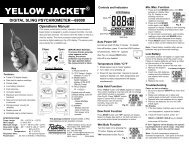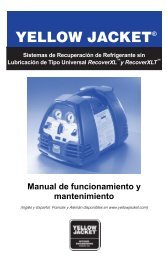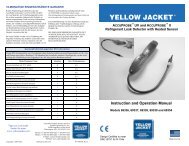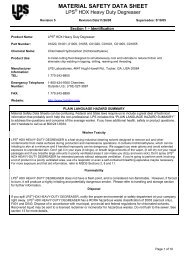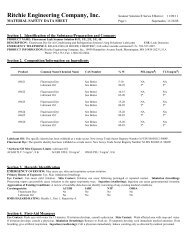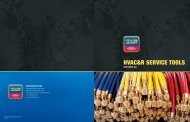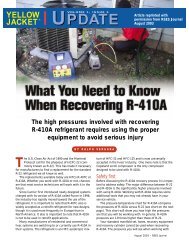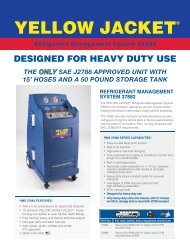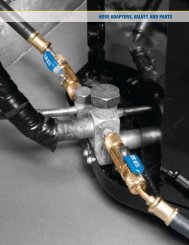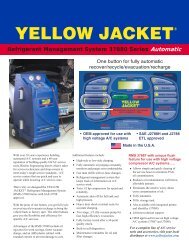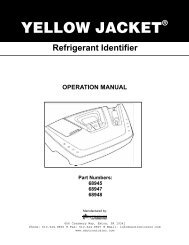YELLOW JACKET High Vacuum Pump Oil 1 - HVAC-Talk
YELLOW JACKET High Vacuum Pump Oil 1 - HVAC-Talk
YELLOW JACKET High Vacuum Pump Oil 1 - HVAC-Talk
Create successful ePaper yourself
Turn your PDF publications into a flip-book with our unique Google optimized e-Paper software.
<strong>YELLOW</strong> <strong>JACKET</strong>® SuperEvac <strong>Vacuum</strong> <strong>Pump</strong> <strong>Oil</strong><br />
Material Safety Data Sheet<br />
Ritchie Engineering Co., Inc.<br />
<strong>YELLOW</strong> <strong>JACKET</strong> Products Division<br />
10950 Hampshire Avenue South<br />
Bloomington, MN 55438-2623 USA<br />
MSDS No.<br />
634104001<br />
Revision Date 8/24/2009<br />
IMPORTANT: This MSDS is prepared in accordance with 29 CFR 1910.1200. Read this<br />
MSDS before transporting, handling, storing or disposing of this product and forward this<br />
information to employees, customers and users of this product.<br />
Emergency Overview<br />
Physical State Liquid.<br />
Color<br />
Light amber Odor Mild petroleum odor<br />
Protect eyes from misting or spraying material.<br />
Protect exposed skin from repeated or prolonged exposure.<br />
Do not store material in open or unmarked containers.<br />
Spills may create a slipping hazard.<br />
Health Hazard<br />
Fire Hazard<br />
Reactivity<br />
Hazard Rankings<br />
HMIS<br />
1<br />
* = Chronic Health Hazard<br />
Protective Equipment<br />
Minimum Recommended<br />
See Section 8 for Details<br />
1<br />
0<br />
NFPA<br />
0<br />
1<br />
0<br />
SECTION 1. PRODUCT IDENTIFICATION<br />
Trade Name<br />
<strong>YELLOW</strong> <strong>JACKET</strong> SuperEvac <strong>Vacuum</strong> <strong>Pump</strong> <strong>Oil</strong><br />
Technical Contact<br />
(800) 769-8370<br />
Product Number<br />
93091, 93092, 93095, 93096, 93191, 93192, 93194<br />
Medical Emergency<br />
(832) 486-4700<br />
CAS Number<br />
Mixture<br />
CHEMTREC Emergency<br />
(United States Only)<br />
(800) 424-9300<br />
Product Family<br />
Industrial oil<br />
Synonyms<br />
Industrial oil<br />
SECTION 2. COMPOSITION<br />
Component Name(s)<br />
CAS Registry No. Concentration (%)<br />
Hi g hl y -refined p etroleum lubricant oils Various 100<br />
SECTION 3. HAZARDS IDENTIFICATION<br />
Also see Emergency Overview and Hazard Ratings on the top of Page 1 of this MSDS.<br />
Major Route(s) of Entry Skin contact.<br />
Signs and Symptoms of Acute Exposure<br />
Inhalation<br />
Eye Contact<br />
Skin Contact<br />
At elevated temperatures or in enclosed spaces, product mist or vapors may irritate the<br />
mucous membranes of the nose, the throat, bronchi, and lungs.<br />
This product can cause transient mild eye irritation with short-term contact with liquid sprays<br />
or mists. Symptoms include stinging, watering, redness, and swelling.<br />
This material can cause mild skin irritation from prolonged or repeated skin contact.<br />
Injection under the skin can cause inflammation and swelling. Injection of pressurized<br />
hydrocarbons can cause severe, permanent tissue damage. Initial symptoms may be minor.<br />
Injection of petroleum hydrocarbons requires immediate medical attention.<br />
MSDS No. 634104001<br />
Revision Date 8/24/2009<br />
Continued on Next Page Page Number: 1
<strong>YELLOW</strong> <strong>JACKET</strong>® <strong>High</strong> <strong>Vacuum</strong> <strong>Pump</strong> <strong>Oil</strong><br />
Ingestion<br />
Chronic Health Effects<br />
Summary<br />
Conditions Aggravated<br />
by Exposure<br />
Target Organs<br />
Carcinogenic Potential<br />
If swallowed, large volumes of material can cause generalized depression, headache,<br />
drowsiness, nausea, vomiting and diarrhea. Smaller doses can cause a laxative effect. If<br />
aspirated into the lungs, liquid can cause lung damage.<br />
This product contains a petroleum-based mineral oil. Prolonged or repeated skin contact<br />
can cause mild irritation and inflammation characterized by drying, cracking, (dermatitis) or<br />
oil acne. Repeated or prolonged inhalation of petroleum-based mineral oil mists at<br />
concentrations above applicable workplace exposure levels can cause respiratory irritation or<br />
other pulmonary effects.<br />
Disorders of the following organs or organ systems that may be aggravated by significant<br />
exposure to this material or its components include: Skin<br />
May cause damage to the following organs: skin<br />
This product is not known to contain any components at concentrations above 0.1% which<br />
are considered carcinogenic by OSHA, IARC or NTP.<br />
OSHA Hazard Classification is indicated by an "X" in the box adjacent to the hazard title. If no "X" is present,<br />
the product does not exhibit the hazard as defined in the OSHA Hazard Communication Standard (29 CFR<br />
1910.1200).<br />
OSHA Health Hazard Classification<br />
OSHA Physical Hazard Classification<br />
Irritant<br />
Sensitizer<br />
Combustible<br />
Explosive<br />
Pyrophoric<br />
Toxic<br />
<strong>High</strong>ly Toxic<br />
Flammable<br />
Oxidizer<br />
Water-reactive<br />
Corrosive<br />
Carcinogenic<br />
Compressed Gas<br />
Organic Peroxide<br />
Unstable<br />
SECTION 4. FIRST AID MEASURES<br />
Take proper precautions to ensure your own health and safety before attempting rescue or providing first aid.<br />
For more specific information, refer to Exposure Controls and Personal Protection in Section 8 of this MSDS.<br />
Inhalation<br />
Eye Contact<br />
Skin Contact<br />
Ingestion<br />
Notes to Physician<br />
Vaporization is not expected at ambient temperatures. This material is not expected to cause<br />
inhalation-related disorders under anticipated conditions of use. In case of overexposure,<br />
move the person to fresh air.<br />
Check for and remove contact lenses. Flush eyes with cool, clean, low-pressure water while<br />
occasionally lifting and lowering eyelids. Seek medical attention if excessive tearing, redness,<br />
or pain persists.<br />
If burned by hot material, cool skin by quenching with large amounts of cool water. For<br />
contact with product at ambient temperatures, remove contaminated shoes and clothing.<br />
Wipe off excess material. Wash exposed skin with mild soap and water. Seek medical<br />
attention if tissue appears damaged or if pain or irritation persists. Thoroughly clean<br />
contaminated clothing before reuse. Clean or discard contaminated leather goods. If material<br />
is injected under the skin, seek medical attention immediately.<br />
Do not induce vomiting unless directed to by a physician. Do not give anything to drink unless<br />
directed to by a physician. Never give anything by mouth to a person who is not fully<br />
conscious. If significant amounts are swallowed or irritation or discomfort occurs, seek<br />
medical attention immediately.<br />
SKIN: In the event of injection in underlying tissue, immediate treatment should include<br />
extensive incision, debridement and saline irrigation. Inadequate treatment can result in<br />
ischemia and gangrene. Early symptoms may be minimal.<br />
INGESTION: The viscosity range of the product(s) represented by this MSDS is greater than<br />
100 SUS at 100°F. Careful gastric lavage may be considered to evacuate large quantities of<br />
material.<br />
MSDS No. 634104001<br />
Revision Date 8/24/2009<br />
Continued on Next Page Page Number: 2
<strong>YELLOW</strong> <strong>JACKET</strong>® <strong>High</strong> <strong>Vacuum</strong> <strong>Pump</strong> <strong>Oil</strong><br />
SECTION 5. FIRE FIGHTING MEASURES<br />
NFPA Flammability<br />
Classification<br />
Flash Point<br />
Lower Flammable Limit<br />
Autoignition<br />
Temperature<br />
Hazardous Combustion<br />
Products<br />
Special Properties<br />
Extinguishing Media<br />
Protection of Fire<br />
Fighters<br />
NFPA Class-IIIB combustible material.<br />
Closed cup: 220°C (428°F). (Pensky-Martens (ASTM D-93)) Open cup: 227°C (441°F)<br />
(Cleveland.).<br />
No data.<br />
Not available.<br />
Upper Flammable Limit<br />
No data.<br />
Carbon dioxide, carbon monoxide, smoke, fumes, unburned hydrocarbons and oxides of<br />
sulfur and/or nitrogen.<br />
This material can burn but will not readily ignite. This material will release vapors when<br />
heated above the flash point temperature that can ignite when exposed to a source of<br />
ignition. In enclosed spaces, heated vapor can ignite with explosive force. Mists or sprays<br />
may burn at temperatures below the flash point.<br />
Use dry chemical, foam, carbon dioxide or water fog. Water or foam may cause frothing.<br />
Carbon dioxide and inert gas can displace oxygen. Use caution when applying carbon<br />
dioxide or inert gas in confined spaces.<br />
Firefighters must use full bunker gear including NIOSH-approved positive pressure<br />
self-contained breathing apparatus to protect against potential hazardous combustion or<br />
decomposition products and oxygen deficiencies.<br />
SECTION 6. ACCIDENTAL RELEASE MEASURES<br />
Take proper precautions to ensure your own health and safety before attempting spill control or clean-up. For<br />
more specific information, refer to the Emergency Overview on Page 1, Exposure Controls and Personal<br />
Protection in Section 8 and Disposal Considerations in Section 13 of this MSDS.<br />
Do not touch damaged containers or spilled material unless wearing appropriate protective<br />
equipment. Slipping hazard; do not walk through spilled material. Stop leak if you can do so<br />
without risk. For small spills, absorb or cover with dry earth, sand, or other inert<br />
non-combustible absorbent material and place into waste containers for later disposal.<br />
Contain large spills to maximize product recovery or disposal. Prevent entry into waterways or<br />
sewers. In urban area, cleanup spill as soon as possible. In natural environments, seek<br />
cleanup advice from specialists to minimize physical habitat damage. This material will float<br />
on water. Absorbent pads and similar materials can be used. Comply with all laws and<br />
regulations.<br />
SECTION 7. HANDLING AND STORAGE<br />
Handling<br />
Keep containers closed and do not handle or store near heat, sparks, or any other potential<br />
ignition sources. Avoid contact with oxidizing agents. Never siphon by mouth. Avoid contact<br />
with eyes, skin, and clothing. Avoid contamination and extreme temperatures.<br />
Empty containers may contain product residues that can ignite with explosive force. Drain<br />
and purge equipment, as necessary, to remove material residues. Follow proper entry<br />
procedures, including compliance with 29 CFR 1910.146 prior to entering confined spaces<br />
such as tanks or pits. Use appropriate respiratory protection when concentrations exceed any<br />
established occupational exposure level (See Section 8). Promptly remove contaminated<br />
clothing. Wash exposed skin thoroughly with soap and water after handling.<br />
Do not pressurize, cut, weld, braze solder, drill, grind or expose containers to flames, sparks,<br />
heat or other potential ignition sources. Protect containers against physical damage. Consult<br />
appropriate federal, state and local authorities before reusing, reconditioning, reclaiming,<br />
recycling or disposing of empty containers and/or waste residues of this product.<br />
MSDS No. 634104001<br />
Revision Date 8/24/2009<br />
Continued on Next Page Page Number: 3
<strong>YELLOW</strong> <strong>JACKET</strong>® <strong>High</strong> <strong>Vacuum</strong> <strong>Pump</strong> <strong>Oil</strong><br />
Storage<br />
Keep container tightly closed. Store in a cool, dry, well-ventilated area. Store only in<br />
approved containers. Do not store with strong oxidizing agents. Do not store at elevated<br />
temperatures. Avoid storing product in direct sunlight for extended periods of time. Storage<br />
area must meet OSHA requirements and applicable fire codes. Consult appropriate federal,<br />
state and local authorities before reusing, reconditioning, reclaiming, recycling or disposing of<br />
empty containers or waste residues of this product.<br />
SECTION 8. EXPOSURE CONTROLS AND PERSONAL PROTECTION<br />
Engineering Controls<br />
Personal Protective<br />
Equipment<br />
Provide exhaust ventilation or other engineering controls to keep the airborne concentrations<br />
of mists and/or vapors below the recommended exposure limits (see below). An eye wash<br />
station and safety shower should be located near the work-station.<br />
Personal protective equipment should be selected based upon the conditions under which<br />
this material is used. A hazard assessment of the work area for PPE requirements should<br />
be conducted by a qualified professional pursuant to OSHA regulations. The following<br />
pictograms represent the minimum requirements for personal protective equipment. For<br />
certain operations, additional PPE may be required.<br />
Eye Protection<br />
Hand Protection<br />
Body Protection<br />
Respiratory Protection<br />
General Comments<br />
Safety glasses equipped with side shields are recommended as minimum protection in<br />
industrial settings. Wear goggles if splashing or spraying is anticipated. Wear goggles and<br />
face shield if material is heated above 125°F (51°C). Have suitable eye wash water<br />
available.<br />
None required for incidental contact. Use gloves constructed of chemical resistant materials<br />
such as heavy nitrile rubber if frequent or prolonged contact is expected. Use<br />
heat-protective gloves when handling product at elevated temperatures.<br />
Use clean protective clothing if splashing or spraying conditions are present. Protective<br />
clothing may include long-sleeve outer garment, apron, or lab coat. If significant contact<br />
occurs, remove oil-contaminated clothing as soon as possible and promptly shower.<br />
Launder contaminated clothing before reuse or discard. Wear heat protective boots and<br />
protective clothing when handling material at elevated temperatures.<br />
The need for respiratory protection is not anticipated under normal use conditions and with<br />
adequate ventilation. If elevated airborne concentrations above applicable workplace<br />
exposure levels are anticipated, a NIOSH-approved organic vapor respirator equipped with a<br />
dust/mist prefilter should be used. Protection factors vary depending upon the type of<br />
respirator used. Respirators should be used in accordance with OSHA requirements (29<br />
CFR 1910.134).<br />
Use good personal hygiene practices. Wash hands and other exposed skin areas with<br />
plenty of mild soap and water before eating, drinking, smoking, use of toilet facilities, or<br />
leaving work. DO NOT use gasoline, kerosene, solvents or harsh abrasives as skin<br />
cleaners. Since specific exposure standards/control limits have not been established for this<br />
product, the "<strong>Oil</strong> Mist, Mineral" exposure limits shown below are suggested as minimum<br />
control guidelines.<br />
Occupational Exposure Guidelines<br />
Substance<br />
<strong>Oil</strong> Mist, Mineral<br />
Applicable Workplace Exposure Levels<br />
ACGIH TLV (United States).<br />
TWA: 5 mg/m 3 8 hour(s).<br />
STEL: 10 mg/m 3 15 minute(s).<br />
OSHA PEL (United States).<br />
TWA: 5 mg/m 3 8 hour(s).<br />
MSDS No. 634104001<br />
Revision Date 8/24/2009<br />
Continued on Next Page Page Number: 4
<strong>YELLOW</strong> <strong>JACKET</strong>® <strong>High</strong> <strong>Vacuum</strong> <strong>Pump</strong> <strong>Oil</strong><br />
SECTION 9. PHYSICAL AND CHEMICAL PROPERTIES (TYPICAL)<br />
Physical State Liquid. Color Light amber Odor Mild petroleum odor<br />
Specific Gravity 0.87 (Water = 1) pH Not applicable Vapor >1 (Air = 1)<br />
Density<br />
Boiling Range<br />
Vapor Pressure<br />
Not available.<br />
2000 mg/kg [Rabbit].<br />
Mineral oil mists derived from highly refined oils are reported to have low acute and sub-acute<br />
toxicities in animals. Effects from single and short-term repeated exposures to high<br />
concentrations of mineral oil mists well above applicable workplace exposure levels include<br />
lung inflammatory reaction, lipoid granuloma formation and lipoid pneumonia. In acute and<br />
sub-acute studies involving exposures to lower concentrations of mineral oil mists at or near<br />
current work place exposure levels produced no significant toxicological effects. In long term<br />
studies (up to two years) no carcinogenic effects have been reported in any animal species<br />
tested.<br />
MSDS No. 634104001<br />
Revision Date 8/24/2009<br />
Continued on Next Page Page Number: 5
<strong>YELLOW</strong> <strong>JACKET</strong>® <strong>High</strong> <strong>Vacuum</strong> <strong>Pump</strong> <strong>Oil</strong><br />
SECTION 12. ECOLOGICAL INFORMATION<br />
Ecotoxicity<br />
Environmental Fate<br />
Analysis for ecological effects has not been conducted on this product. However, if spilled,<br />
this product and any contaminated soil or water may be harmful to human, animal, and<br />
aquatic life. Also, the coating action associated with petroleum and petroleum products can<br />
be harmful or fatal to aquatic life and waterfowl.<br />
Biodegradability: Inherently biodegradable in aerobic conditions.<br />
Partition Coefficient (log Kow): >6 (based on similar materials)<br />
Photodegradation: Based on similar materials, this product will have little or no tendency to<br />
partition to air. Hydrocarbons from this product which do partition to air are expected to<br />
rapidly photodegrade.<br />
Stability in Water: Not readily susceptible to hydrolysis under aquatic conditions.<br />
Distribution: Principally to soil and sediment. Petroleum-based (mineral) lubricating oils<br />
normally will float on water. In stagnant or slow-flowing waterways, an oil layer can cover a<br />
large surface area. As a result, this oil layer might limit or eliminate natural atmospheric<br />
oxygen transport into the water. With time, if not removed, oxygen depletion in the waterway<br />
may be sufficient to cause a fish kill or create an anaerobic environment.<br />
SECTION 13. DISPOSAL CONSIDERATIONS<br />
Hazard characteristic and regulatory waste stream classification can change with product use. Accordingly, it is<br />
the responsibility of the user to determine the proper storage, transportation, treatment and/or disposal<br />
methodologies for spent materials and residues at the time of disposition.<br />
Conditions of use may cause this material to become a "hazardous waste", as defined by<br />
federal or state regulations. It is the responsibility of the user to determine if the material is a<br />
"hazardous waste" at the time of disposal. Transportation, treatment, storage, and disposal<br />
of waste material must be conducted in accordance with RCRA regulations (see 40 CFR 260<br />
through 40 CFR 271). State and/or local regulations may be more restrictive. Contact your<br />
regional US EPA office for guidance concerning case specific disposal issues. Empty drums<br />
and pails retain residue. DO NOT pressurize, cut, weld, braze, solder, drill, grind, or expose<br />
this product's empty container to heat, flame, or other ignition sources. DO NOT attempt to<br />
clean it. Empty drums and pails should be drained completely, properly bunged or sealed,<br />
and promptly sent to a reconditioner.<br />
SECTION 14. TRANSPORT INFORMATION<br />
The shipping description below may not represent requirements for all modes of transportation, shipping<br />
methods or locations outside of the United States.<br />
US DOT Status Not regulated by the U.S. Department of Transportation as a hazardous material.<br />
Proper Shipping Name Not regulated.<br />
Hazard Class<br />
Reportable Quantity<br />
Placard(s)<br />
Not regulated.<br />
Packing Group<br />
UN/NA Number<br />
A Reportable Quantity (RQ) has not been established for this material.<br />
Not applicable.<br />
Not regulated.<br />
MSDS No. 634104001<br />
Revision Date 8/24/2009<br />
Continued on Next Page Page Number: 6
<strong>YELLOW</strong> <strong>JACKET</strong>® <strong>High</strong> <strong>Vacuum</strong> <strong>Pump</strong> <strong>Oil</strong><br />
SECTION 15. REGULATORY INFORMATION<br />
Emergency Response<br />
Guide No.<br />
MARPOL III Status<br />
Not applicable.<br />
Not a DOT "Marine<br />
Pollutant" per 49 CFR<br />
171.8.<br />
<strong>Oil</strong>: The product(s) represented by this MSDS is (are)<br />
regulated as “oil” under 49 CFR Part 130. Shipments by<br />
rail or highway in packaging having a capacity of 3500<br />
gallons or more or in a quantity greater 42,000 gallons<br />
are subject to these requirements. In addition, mixtures<br />
containing 10% or more of this product may be subject to<br />
these requirements.<br />
TSCA Inventory<br />
SARA 302/304<br />
Emergency Planning<br />
and Notification<br />
SARA 311/312 Hazard<br />
Identification<br />
SARA 313 Toxic<br />
Chemical Notification<br />
and Release Reporting<br />
CERCLA<br />
Clean Water Act<br />
(CWA)<br />
California<br />
Proposition 65<br />
New Jersey<br />
Right-to-Know Label<br />
Additional Remarks<br />
This product and/or its components are listed on the Toxic Substances Control Act (TSCA)<br />
inventory.<br />
The Superfund Amendments and Reauthorization Act of 1986 (SARA) Title III requires<br />
facilities subject to Subparts 302 and 304 to submit emergency planning and notification<br />
information based on Threshold Planning Quantities (TPQs) and Reportable Quantities<br />
(RQs) for "Extremely Hazardous Substances" listed in 40 CFR 302.4 and 40 CFR 355. No<br />
components were identified.<br />
The Superfund Amendments and Reauthorization Act of 1986 (SARA) Title III requires<br />
facilities subject to this subpart to submit aggregate information on chemicals by "Hazard<br />
Category" as defined in 40 CFR 370.2. This material would be classified under the following<br />
hazard categories:<br />
No SARA 311/312 hazard categories identified.<br />
This product contains the following components in concentrations above de minimis levels<br />
that are listed as toxic chemicals in 40 CFR Part 372 pursuant to the requirements of Section<br />
313 of SARA: No components were identified.<br />
The Comprehensive Environmental Response, Compensation, and Liability Act of 1980<br />
(CERCLA) requires notification of the National Response Center concerning release of<br />
quantities of "hazardous substances" equal to or greater than the reportable quantities (RQ's)<br />
listed in 40 CFR 302.4. As defined by CERCLA, the term "hazardous substance" does not<br />
include petroleum, including crude oil or any fraction thereof which is not otherwise<br />
specifically designated in 40 CFR 302.4. This product or refinery stream is not known to<br />
contain chemical substances subject to this statute. However, it is recommended that you<br />
contact state and local authorities to determine if there are any other reporting requirements<br />
in the event of a spill.<br />
This material is classified as an oil under Section 311 of the Clean Water Act (CWA) and the<br />
<strong>Oil</strong> Pollution Act of 1990 (OPA). Discharges or spills which produce a visible sheen on waters<br />
of the United States, their adjoining shorelines, or into conduits leading to surface waters must<br />
be reported to the EPA's National Response Center at (800) 424-8802.<br />
This product is not known to contain any components for which the State of California has<br />
found to cause cancer, birth defects or other reproductive harm.<br />
Petroleum <strong>Oil</strong><br />
No additional regulatory remarks.<br />
MSDS No. 634104001<br />
Revision Date 8/24/2009<br />
Continued on Next Page Page Number: 7
<strong>YELLOW</strong> <strong>JACKET</strong>® <strong>High</strong> <strong>Vacuum</strong> <strong>Pump</strong> <strong>Oil</strong><br />
SECTION 16. OTHER INFORMATION<br />
Refer to the top of Page 1 for the HMIS and NFPA Hazard Ratings for this product.<br />
REVISION INFORMATION<br />
Version Number 2.0<br />
Revision Date 8/24/2009<br />
ABBREVIATIONS<br />
AP: Approximately EQ: Equal >: Greater Than



